Estimation of Humidity Variation and Electric Resistivity in Hardened Concrete by Means of a Stainless Steel Voltammetric Sensor
Abstract
:1. Introduction
- (1)
- detecting and verifying if any damage is, or aggressive agents are, present in the structure;
- (2)
- locating any risk zones;
- (3)
- estimating/quantifying harm or the presence of aggressive agents;
- (4)
- making a prognosis of, or predicting, the structure’s service life under these conditions.
2. Experimental
2.1. Sensor System
2.1.1. Electro-Analytical Techniques
2.1.2. Electrodes
2.2. Methodology
- The estimation model of humidity variation: this was obtained with the correlation of the electric resistance (Rs) data obtained with the weight variation of samples after submitting them to different humidity conditions.
- The estimation model of concrete’s electric resistivity: this was obtained with the correlation of the empirical electric resistivity (ρ) and electric resistance (Rs) data obtained with the sensor system.
2.3. Samples and Materials
- the humidity variations in the environment would quickly affect the zone where sensors were;
- sensors were not affected by any uncontrolled defects on concrete surfaces (hollows, etc.).
2.4. Preparing Samples
2.5. Tests
2.5.1. Electric Resistivity Measurement
2.5.2. Concrete Characterization Tests
- Hardened concrete tests. To determine resistance to compression (UNE 12390-3:2009). Resistance to compression was determined at 28 days (fc). Two cylindrical samples were prepared (10 cm diameter, 20 cm high) for each mass at each dose. Total number of samples: 36.
- Determining water absorption, density and accessible porosity for water (UNE 83980:2014). Testing was conducted at 28 days. Two cylindrical samples were prepared (10 cm diameter, 5 cm high) for each mass at each dose. Total number of samples: 36.
- Determining air permeability (UNE 83981:2008). Testing was conducted at 28 days. Two cylindrical samples were prepared (15 cm diameter, 5 cm high) for each mass at each dose. To run the test, sample sides were covered with sealing paint. The air permeability coefficient (k) was obtained. Total number of samples: 36.
- Determining electrical resistivity (ρ): direct (reference) method (UNE 83988-1:2008). Progression over time. Two prismatic samples were prepared (4 × 4 × 16 cm3) for each mass at each dose. Total number of samples: 36.
- Determining the water cover depth under pressure (UNE 83-309-90). A test was conducted at 28 days. For this test, two samples were prepared (15 cm diameter and 30 cm high for each mass at each dose. Total number of samples: 36.
- Accelerated chloride diffusion test according to Standard NT-BUILD 492. A test was run at 28 days. Two samples were manufactured (5 cm diameter, 10 cm high) for each mass at each dose. Total number of samples: 36.
3. Results and Discussion
3.1. Concrete Characterization Tests
- Very low-durability concretes: w/c = 0.9 and w/c = 0.8. These concretes are not covered by Spanish Standard EHE-08 for their structural use. Their use is justified when the sensor needs to be characterized within a wide range of porosities.
- Low-durability concrete: w/c = 0.6.
- Medium-durability concrete: w/c = 0.5.
- High-durability concrete: w/c = 0.4 and w/c = 0.3.
3.2. Humidity and Electric Resistivity Models
3.2.1. Estimation Model of Humidity Variation
Model Validation
3.2.2. Estimation Model of Concrete’s Electric Resistivity
Model Validation
4. Conclusions
- The developed sensor system allows a reliable estimation model of concrete’s humidity variation to be established. It accounts for 88.9% of data variance.
- As Δm/m0 = f(ρ) and Δm/m0 = f(Rs) functions have the same curve morphology, their empirical data fit the same function typology.
- This study demonstrates how the electric field generated in the sensor system cannot be considered uniform because no uniform linear correlation exists between electric resistivity and electric resistance. This means that uniform field simplifications cannot be used to achieve electric resistivity by means of the sensor system.
- With the correlation between functions Δm/m0 = f(ρ) and Δm/m0 = f(Rs), the estimation model of electric resistivity by the parameter is obtained with the sensor system’s Rs. This model offers good reproducibility of reality by accounting for 94% of data variance.
- Working with two electrodes implies there are no limitations to the developed models’ reliability and reduces the energy needed for the system.
- •
- The sensor system presented with the developed models can be coupled to a multi-sensor system, developed according to the smart sensor network concept. Depending on data requirements about the state, this sensor network is capable of collecting interesting data at the necessary points to optimize the system’s data resources, and its economic and energy uses.
- •
- It is possible to collect further information from the electric resistivity estimation to characterize the degree of corrosion with these relations:
- ✓
- The correlation between the electric resistivity value and the presence of chlorides. Initial tests can be conducted to check if the model slightly varies when chloride anions are present in the concrete’s porous solution.
- ✓
- The correlation between concrete’s electric resistivity and the corrosion electric current, which are correlated by Ampère’s Law.
Author Contributions
Funding
Institutional Review Board Statement
Informed Consent Statement
Data Availability Statement
Conflicts of Interest
References
- Naik, T.R. Sustainability of Concrete Construction. Pract Period Struct Des. Constr. 2008, 13, 98–103. [Google Scholar] [CrossRef]
- Biswas, R.K.; Iwanami, M.; Chijiwa, N.; Uno, K. Effect of non-uniform rebar corrosion on structural performance of RC structures: A numerical and experimental investigation. Constr. Build. Mater. 2020, 230, 116908. [Google Scholar] [CrossRef]
- Fernandez, I.; Berrocal, C.G. Mechanical Properties of 30 Year-Old Naturally Corroded Steel Reinforcing Bars. Int. J. Concr. Struct. Mater. 2019, 13, 9. [Google Scholar] [CrossRef]
- Almusallam, A.A. Effect of degree of corrosion on the properties of reinforcing steel bars. Constr. Build. Mater. 2001, 15, 361–368. [Google Scholar] [CrossRef]
- Tutti, K. Corrosion of Steel in Concrete; Swedish Cement and Concrete Institute: Stokholm, Sweden, 1982. [Google Scholar]
- Linares Alemparte, P. Caracterización del Hormigón en Relación a la Difusión de Gases y su Correlación con el Radón. Ph.D. Thesis, Universidad Politécnica Madrid, Madrid, Spain, 2015. [Google Scholar]
- Lee, H.M.; Lee, H.S.; Min, S.H.; Lim, S.; Singh, J.K. Carbonation-induced corrosion initiation probability of rebars in concretewith/without finishing materials. Sustainability 2018, 10, 3841. [Google Scholar] [CrossRef]
- Singh, D.V.; Sachan, A.K.; Rawat, A. Developments in corrosion detection techniques for reinforced concrete structures. Indian J. Sci. Technol. 2016, 9, 30. [Google Scholar] [CrossRef]
- Laurens, S.; Hénocq, P.; Rouleau, N.; Deby, F.; Samson, E.; Marchand, J.; Bissonnette, B. Steady-state polarization response of chloride-induced macrocell corrosion systems in steel reinforced concrete—Numerical and experimental investigations. Cem. Concr. Res. 2016, 79, 272–290. [Google Scholar] [CrossRef]
- Hansson, C.M.; Poursaee, A.; Laurent, A. Macrocell and microcell corrosion of steel in ordinary Portland cement and high performance concretes. Cem. Concr. Res. 2006, 36, 2098–2102. [Google Scholar] [CrossRef]
- Elsener, B. Macrocell corrosion of steel in concrete—Implications for corrosion monitoring. Cem. Concr. Compos. 2002, 24, 65–72. [Google Scholar] [CrossRef]
- Priou, J.; Lecieux, Y.; Chevreuil, M.; Gaillard, V.; Lupi, C.; Leduc, D.; Rozière, E.; Guyard, R.; Schoefs, F. In situ DC electrical resistivity mapping performed in a reinforced concrete wharf using embedded sensors. Constr. Build. Mater. 2019, 211, 244–260. [Google Scholar] [CrossRef]
- Azarsa, P.; Gupta, R. Resistivity of Concrete for ElectricalDurability Evaluation: A Review. Adv. Mater. Sci. Eng. 2017, 2017, 1–30. [Google Scholar] [CrossRef]
- Feliu, S.; Andrade, C.; González, J.A.; Alonso, C. A new method for in-situ measurement of electrical resistivity of reinforced concrete. Mater. Struct. Constr. 1996, 29, 362–365. [Google Scholar] [CrossRef]
- Buasiri, T.; Habermehl-Cwirzen, K.; Krzeminski, L.; Cwirzen, A. Novel humidity sensors based on nanomodified Portland cement. Sci. Rep. 2021, 11, 8189. [Google Scholar] [CrossRef]
- Zhou, S.; Deng, F.; Yu, L.; Li, B.; Wu, X.; Yin, B. A novel passive wireless sensor for concrete humidity monitoring. Sensors 2016, 16, 1535. [Google Scholar] [CrossRef] [PubMed]
- Alzeyadi, A.; Yu, T. Moisture determination of concrete panel using SAR imaging and the K-R-I transform. Constr. Build. Mater. 2018, 184, 351–360. [Google Scholar] [CrossRef]
- Alzeyadi, A.; Yu, T. Subsurface characterization of moisture content and water-to-cement ratio of concrete specimens using remote synthetic aperture radar imaging Subsurface characterization of moisture content and water-to-cement ratio of concrete specimens using remote synthetic aperture radar imaging. J. Appl. Remote Sens. 2020, 14, 024520. [Google Scholar]
- Zhang, H.; Li, J.; Kang, F. Real-time monitoring of humidity inside concrete structures utilizing embedded smart aggregates. Constr. Build. Mater. 2022, 331, 127317. [Google Scholar] [CrossRef]
- Ghods, P.; Alizadeh, A.R.; Salehi, M. Electrical Resistivity of Concrete. Concr. Int. 2015, 35, 41–46. [Google Scholar]
- Ramón, J.E.; Martínez, I.; Gandía-romero, J.M.; Soto, J. An embedded-sensor approach for concrete resistivity measurement in on-site corrosion monitoring: Cell constants determination. Sensors 2021, 21, 2481. [Google Scholar] [CrossRef]
- Martínez-Ibernón, A.; Roig-Flores, M.; Lliso-Ferrando, J.; Mezquida-Alcaraz, E.; Valcuende, M.; Serna, P. Influence of cracking on oxygen transport in UHPFRC using stainless steel sensors. Appl. Sci. 2020, 10, 239. [Google Scholar] [CrossRef]
- Martínez-Ibernón, A.; Lliso-Ferrando, J.; Gandía-Romero, J.M.; Soto, J. Stainless Steel Voltammetric Sensor to Monitor Variations in Oxygen and Humidity Availability in Reinforcement Concrete Structures. Sensors 2021, 21, 2851. Available online: https://www.mdpi.com/1424-8220/21/8/2851 (accessed on 18 April 2021). [CrossRef] [PubMed]
- Ramón Zamora, J.E. Sistema de Sensores Embebidos para Monitorizar la Corrosión en Estructuras de Hormigón Armado. Fundamentos, Metodología y Aplicaciones. Ph.D. Thesis, Univ Politècnica València, València, Spain, 2018. [Google Scholar]
- Martínez-Ibernón, A.; Ramón, J.E.; Gandía-Romero, J.M.; Gasch, I.; Valcuende, M.; Alcañiz, M.; Soto, J. Characterization of electrochemical systems using potential step voltammetry. Part II: Modeling of reversible systems. Electrochim. Acta 2019, 328, 135111. Available online: https://linkinghub.elsevier.com/retrieve/pii/S0013468619319826 (accessed on 18 April 2021). [CrossRef]
- Martinez Ibernon, A.; Gasch, I.; Romero, J.M.G.; Soto, J. Hardened Concrete State Determination System Based on a Stainless Steel Voltammetric Sensor and PCA Analysis. IEEE Sens. J. 2022, 22, 12947–12958. Available online: https://ieeexplore.ieee.org/document/9757187/ (accessed on 14 April 2022). [CrossRef]
- ASTM COMPASS, ®. Standard Practice for Maintaining Constant Relative Humidity by Means of Aqueous Solutions. ASTM Des. E 2018, 2, 2018. [Google Scholar]
- Norberg, P. Electrical measurement of moisture content in porous building materials. Durab. Build. Mater. Compon. 1999, 8, 1030–1039. [Google Scholar]
- Groupe de Travail CONCEPTION des Bétons Pour une Durée de vie Donnée des Ouvrages—Indicateurs de Durabilité (France). In Conception des Bétons Pour une Durée de vie Donnée des Ouvrages: Maîtrise de la Durabilité vis-à-vis de la Corrosion des Armatures et de L’alcali-Réaction; Baroghel-Bouny, V.; Jacob, J. (Eds.) (Documents Scientifiques et Techniques—Association Française de Génie civil); AFGC: Paris, France, 2004; Available online: https://books.google.es/books?id=YuobcgAACAAJ (accessed on 18 April 2021).
- Stamm, A.J. The Electrical Resistance of Wood as a Measure of Its Moisture Content. Ind. Eng. Chem. 1927, 19, 1021–1025. [Google Scholar] [CrossRef]
- de Medeiros-Junior, R.A.; da Munhoz, G.S.; de Medeiros, M.H.F. Correlations between water absorption, electrical resistivity and compressive strength of concrete with different contents of pozzolan. Rev. Alconpat. 2019, 9, 152–166. [Google Scholar] [CrossRef] [Green Version]
- Kazmi, D.; Qasim, S.; Siddiqui, F.I.; Azhar, S.B. Exploring the Relationship between Moisture Content and Electrical Resistivity for Sandy and Silty Soils. Int. J. Eng. Sci. Invent. 2016, 5, 42–47. [Google Scholar]
- Machado, J.E.O. Características Físico Mecánicas y Análisis de Calidad de granos. Univ. Nacional de Colombia. Available online: https://books.google.com.co/books?id=2DWmqb6xP3wC (accessed on 18 April 2021).

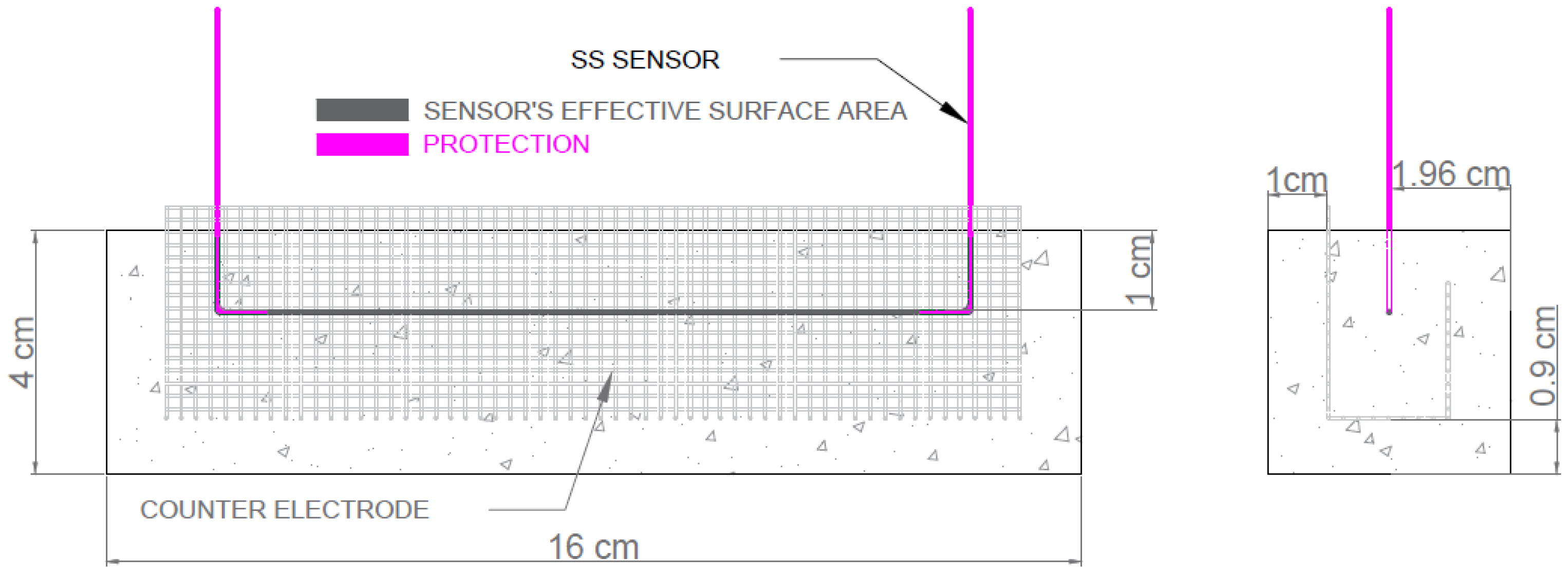

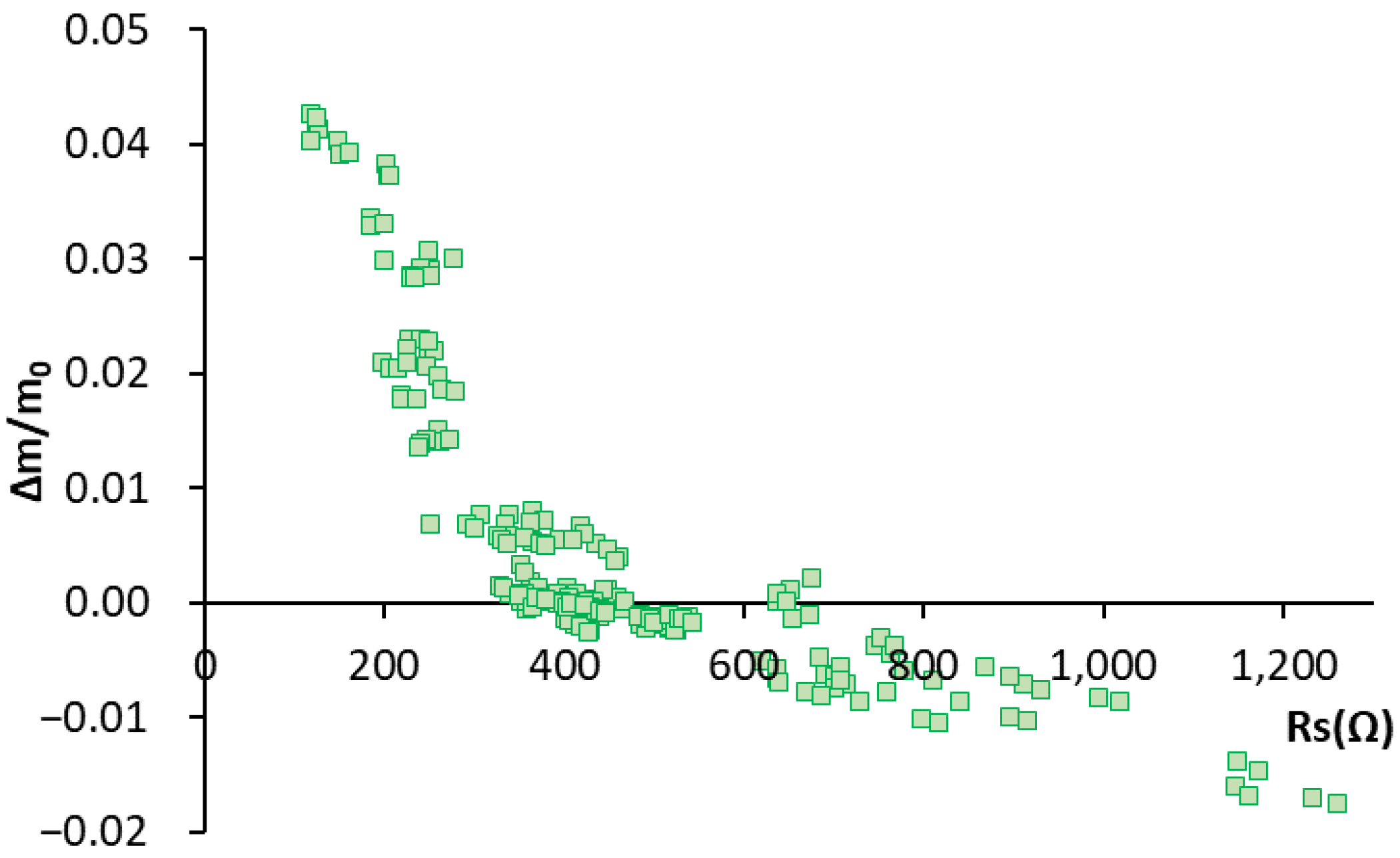
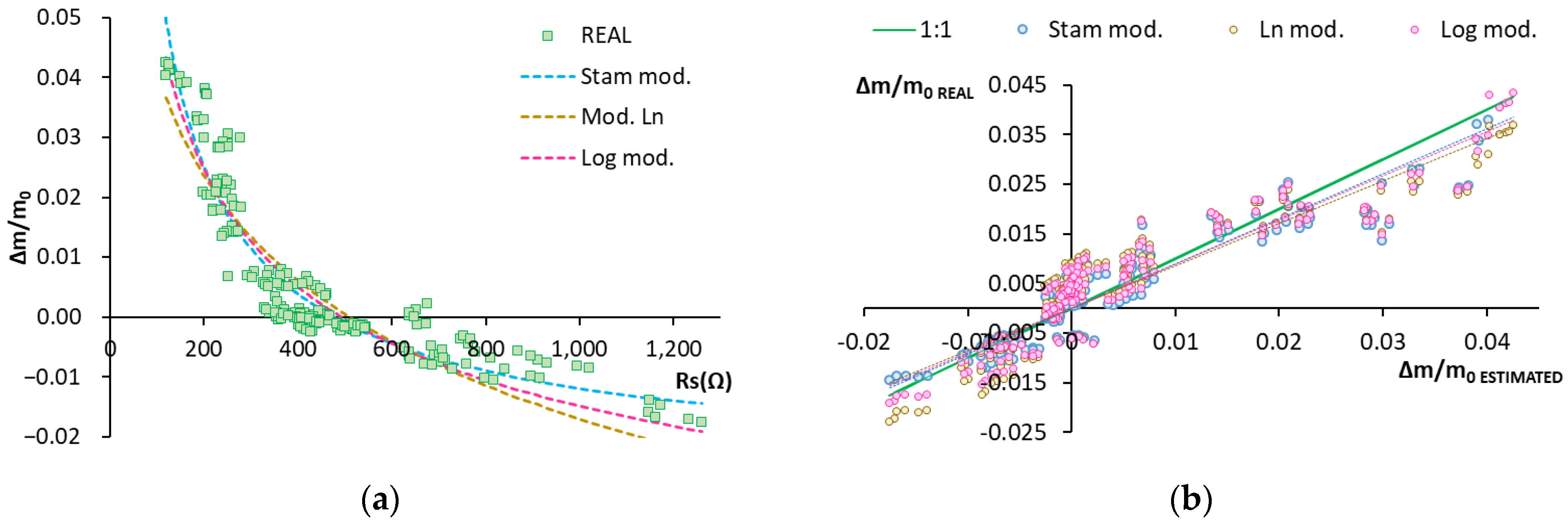



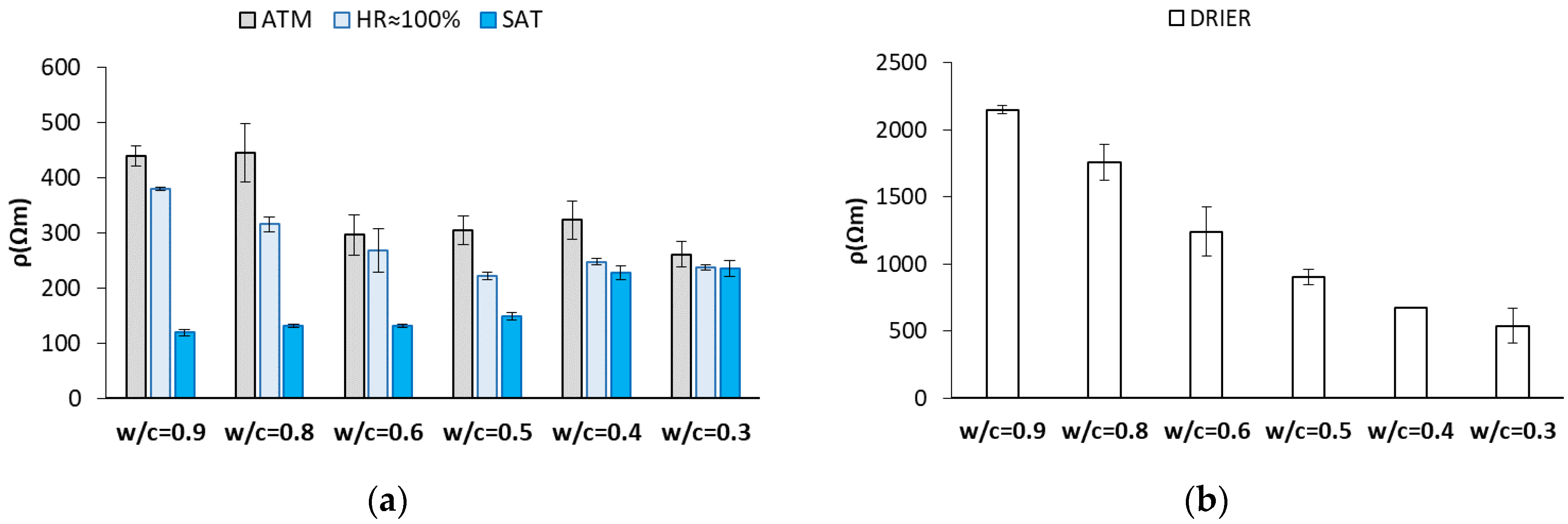
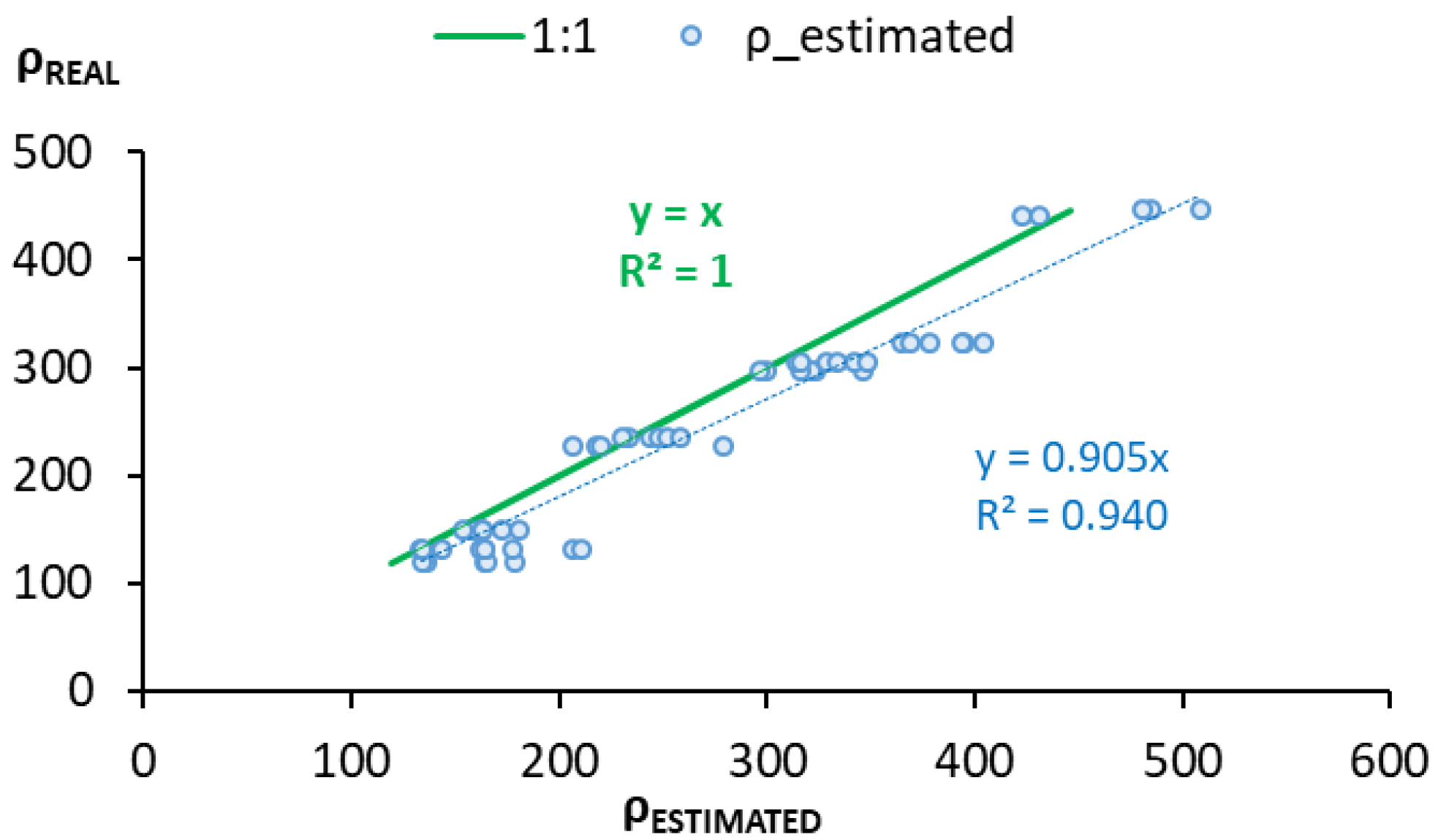
| Materials | kg/m3concrete | |||||
|---|---|---|---|---|---|---|
| w/c = 0.9 | w/c = 0.8 | w/c = 0.6 | w/c = 0.5 | w/c = 0.4 | w/c = 0.3 | |
| I 42.5 R-SR5 cement | 225 | 250 | 315 | 385 | 490 | 650 |
| Water | 203 | 200 | 189 | 193 | 196 | 195 |
| Superplasticizer | 1.6 | 1.8 | 2.2 | 2.7 | 3.4 | 4.6 |
| Silica sand | 1433 | 1431 | 1212 | 1179 | 1115 | 1108 |
| Gravel | 478 | 477 | 653 | 635 | 601 | 475 |
| fc,28days (MPa) | % Abs. Water | % P.A.W | P.W.P (mm) | k (×10−18 m2) | ρ (Ωm) | Dnssm (×10−12 m2/s) | |
|---|---|---|---|---|---|---|---|
| w/c = 0.9 | 15.46 | 8.65% | 18.38% | 150 | 996.44 | 135.87 | 72.71 |
| w/c = 0.8 | 18.98 | 8.38% | 18.24% | 103 | 432.15 | 170.36 | 50.04 |
| w/c = 0.6 | 30.74 | 7.82% | 17.00% | 18 | 258.84 | 178.89 | 45.22 |
| w/c = 0.5 | 40.50 | 7.49% | 16.42% | 18 | 50.37 | 195.69 | 25.35 |
| w/c = 0.4 | 60.94 | 6.58% | 14.63% | 8 | 5.68 | 213.22 | 9.70 |
| w/c = 0.3 | 73.52 | 5.65% | 12.80% | 0 | 0.00 | 281.69 | 3.73 |
| Avrg Coef V. | 4.24% | 4.45% | 3.86% | 6.99% | 17.33% | 7.87% | 4.24% |
| RMSE | Line Slope Real vs. Estimated | R2 | |
|---|---|---|---|
| Stam mod. | 0.0046 | 0.906 | 0.889 |
| Ln mod. | 0.0057 | 0.855 | 0.826 |
| Log mod. | 0.0050 | 0.891 | 0.870 |
| RMSE | Line Slope Real vs. Estimated | R2 | |
|---|---|---|---|
| Stam mod. | 0.0053 | 0.818 | 0.835 |
| RMSE | Line Slope Real vs. Estimated | R2 | |
|---|---|---|---|
| Stam mod. | 0.0045 | 0.944 | 0.941 |
| Ln mod. | 0.0075 | 0.842 | 0.832 |
| Log mod. | 0.0059 | 0.932 | 0.939 |
| RMSE | Line Slope Real vs. Estimated | R2 | |
|---|---|---|---|
| Stam mod. | 36.444 | 0.905 | 0.940 |
Publisher’s Note: MDPI stays neutral with regard to jurisdictional claims in published maps and institutional affiliations. |
© 2022 by the authors. Licensee MDPI, Basel, Switzerland. This article is an open access article distributed under the terms and conditions of the Creative Commons Attribution (CC BY) license (https://creativecommons.org/licenses/by/4.0/).
Share and Cite
Martínez Ibernón, A.; Lliso Ferrando, J.; Gasch, I.; Valcuende, M. Estimation of Humidity Variation and Electric Resistivity in Hardened Concrete by Means of a Stainless Steel Voltammetric Sensor. Sensors 2022, 22, 7279. https://doi.org/10.3390/s22197279
Martínez Ibernón A, Lliso Ferrando J, Gasch I, Valcuende M. Estimation of Humidity Variation and Electric Resistivity in Hardened Concrete by Means of a Stainless Steel Voltammetric Sensor. Sensors. 2022; 22(19):7279. https://doi.org/10.3390/s22197279
Chicago/Turabian StyleMartínez Ibernón, Ana, Josep Lliso Ferrando, Isabel Gasch, and Manuel Valcuende. 2022. "Estimation of Humidity Variation and Electric Resistivity in Hardened Concrete by Means of a Stainless Steel Voltammetric Sensor" Sensors 22, no. 19: 7279. https://doi.org/10.3390/s22197279





